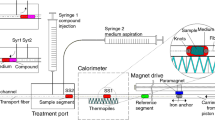Abstract
Bioelectric potentials were recorded from the unstressed tibia in the anesthetized rabbit by means of silver/silver chloride electrodes connected to saline bridges and a high impedence voltmeter. Potentials recorded from the anterior, medial, and lateral surfaces of the tibia indicated that the surface voltage was constant around the transverse axis of a bone but varied in relation to its long axis. Voltages were independent of bony landmarks and points of muscle attachment. The bioelectric potentials changed little after sciatic nerve denervation or ligation of the femoral artery. The potentials decreased dramatically thirty minutes following the intra-arterial administration of dinitrophenol or iodoacetamide. Also, the potentials fell sharply in a localized segment of tibia injured through the application of ultrasound energy. Animal death brought about a slow decay of potential commensurate with the gradual loss of bone cell viability. The experimental evidence from this study suggests that the steady state potentials observed from the surface of unstressed bone are not directly dependent on blood flow or nerve transmission. Rather, such potentials are dependent on a functioning bone cell population, and each recorded potential represents a summation of the electromotive forces from all cells in a localized area.
Résumé
Des potentiels électriques sont enregistrés au niveau du tibia, au repos, d'un lapin anesthésié, et cela à l'aide d'électrodes d'argent/chlorure d'argent, reliées à des ponts salins et un voltmètre à haute impédance. Les potentiels enregistrés à partir des surfaces antérieures, médianes et latérales du tibia indiquent que le voltage de surface est constant autour de l'axe transversale de l'os, mais varie en rapport avec l'axe longitudinal. Les voltages sont indépendants des limites osseuses et points d'attaches musculaires. Ces potentiels bioélectriques varient peu après résection du nerf sciatique ou ligature de l'artère fémorale. Les potentiels décroissent nettement trente minutes après administration intra-artérielle de dinitrophénol ou iodoacétamide. Les potentiels chutent nettement dans un segment localisé du tibia, endommagé par application d'ultra-sons. La mort de l'animal provoque une chute lente de potentiel en rapport avec la perte graduelle de viabilité des cellules osseuses. Il semble que les potentiels de repos, observés à la surface de l'os non stressé, ne sont pas directement liés à la circulation sanguine ou la transmission neurale. Ces potentiels semblent plutôt liés à l'existence d'une population cellulaire osseuse active et chaque potentiel mesuré constitue la somme des forces électromotrices de toutes les cellules d'une région localisée.
Zusammenfassung
Am anaesthesierten Kaninchen wurden die Biopotentiale der unbelasteten Tibia gemessen. Dazu wurden Silber/Silberchlorid-Elektroden benützt, welche über Salzbrücken an ein Voltmeter mit hohem Eingangswiderstand angeschlossen waren. Die an der vorderen, seitlichen und hinteren Tibia-Oberfläche gemessenen Potentiale zeigten, daß die Oberflächenspannung an der Querachse eines Knochens konstant ist, jedoch in bezug zur Längsachse variiert. Die Spannungen waren nicht beeinflußt durch knochentopographische und Muskelansatz-Punkte. Nach Sciaticus-Durchtrennung oder Ligatur der Arterie femoralis änderten sich die bioelektrischen Potentiale nur wenig. Ein eindrücklicher Abfall der Potentiale wurde jedoch 30 min nach intraarterieller Verabreichung von Dinitrophenol oder Jodacetamied beobachtet. Ebenso stark fielen die Potentiale in einem umgrenzten Tibia-Segment ab, das durch Ultraschallbehandlung lädiert worden war. Beim Tod der Tiere wurde ein langsamer Abfall der Potentiale, entsprechend dem allmählichen Verlust an lebenden Knochenzellen, beobachtet. Auf Grund der mit dieser Studie gewonnenen Resultate kann vermutet werden, daß die im Gleichgewicht bleibenden Potentiale der unbelasteten Knochenoberfläche nicht direkt von der Durchblutung oder der nervösen Reizleitung abhängig sind. Es scheint eher, daß dafür eine intakte Knochenzell-Population vorliegen muß, wobei jedes aufgezeichnete Potential eine Summierung der elektromotorischen Kräfte aller Zellen einer bestimmten Region darstellt.
Similar content being viewed by others
References
Bassett, C. A. L., Becker, R. O.: Generation of electrical potentials by bone in response to mechanical stress. Science137, 1063–1064 (1961).
Becker, R. O.: The bioelectric factors in amphibian-limb regeneration. J. Bone J. Surg. A43, 643–656 (1961).
Becker, R. O., Murray, D. G.: The electrical control system regulating fracture healing in amphibians. Clin. Orthop.73, 169–198 (1970).
Burr, H. S.: Bioelectricity: potential gradients. In: Medical physics, vol. 2, p. 90–94, edited by Otto Glasser. Chicago: Yearbook Publishing Co. 1950.
Cater, D. B., Phillips, A. F.: Measurement of electrode potentials in living and dead tissues. Nature (Lond.)174, 121–123 (1954).
Friedenberg, Z. B., Brighton, C. T.: Bioelectric potentials in bone. J. Bone J. Surg. A48, 915–923 (1966).
Fukada, E., Yasuda, I.: On the piezoelectric effect of bone. J. Phys. Soc. Japan10, 1158–1162 (1957).
Lehninger, A. L.: The mitochondrion, p. 92. New York: W. A. Benjamin 1965a.
Lehninger, A. L.: Bioenergetics, p. 140. New York: W. A. Benjamin 1965b.
Ray, R. D., Mosiman, R., Schmidt, S.: Tissue culture studies of bone. J. Bone J. Surg. A36, 1147–1163 (1954).
Sawyer, P. N., Brattin, W. H., Boddy, P. J.: Electrochemical precipitation of human blood cells and its possible relation to intravascular thrombosis (in press).
Author information
Authors and Affiliations
Additional information
Supported in part by Contract N00014-67-A-0216-0010 (NR 105-552) between the Office of Naval Research, Department of the Navy, and the University of Pennsylvania for an advanced clinical research effort between Naval Hospital, Philadelphia, and the University of Pennsylvania.
Rights and permissions
About this article
Cite this article
Friedenberg, Z.B., Harlow, M.C., Heppenstall, R.B. et al. The cellular origin of bioelectric potentials in bone. Calc. Tis Res. 13, 53–62 (1973). https://doi.org/10.1007/BF02015396
Received:
Accepted:
Issue Date:
DOI: https://doi.org/10.1007/BF02015396




